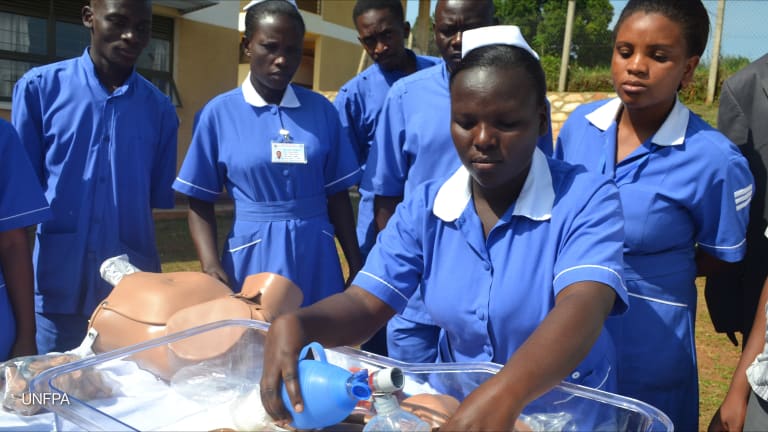
MANILA — Since 2001, the numbers that have come out of Afghanistan have been bleak. Each year, no fewer than 1,000 civilians die. In 2017, that number reached 1,662, as per the United Nations Assistance Mission in Afghanistan. The injured number over 3,000 annually since 2014.
But amid the instability and insecurity emerged some unusual figures: More than 700 fewer maternal deaths for every 100,000 live births; under-five child and newborn mortality rates fell 34 percent and 32 percent, respectively. Childhood stunting dropped at a rate of 2 percent per year, higher than the global average of 1.3 percent.
For a country that’s been in the midst of war for over a decade, these statistics raise a key question: How?
“We’re coming up with three main reasons we think there’s been these improvements across the country,” said Mickey Chopra, lead health specialist, global solutions lead for service delivery at the World Bank and co-author of Progress in the Face of Insecurity: Improving Health Outcomes in Afghanistan.
These include the ministry of health’s chosen service delivery model, its investments in data collection and verification, and government ownership.
See more related topics:
► Opinion: Perception of NGOs in Afghanistan isn't great. Here's how to make it better.
► Opinion: Living with conflict is a sign of resilience, not fragility
► SDG indicators shape maternal health interventions. Is it for the best?
The ministry of health in Afghanistan has been delivering services in three provinces near Kabul — Parwan, Panjshir and Kapisa — but didn’t really have presence in the rest of the country, Chopra said. Instead of trying to cover all, the ministry, with support from its biggest donors which are the World Bank, the United States Agency for International Development, Canada, and the European Union, decided to continue allowing NGOs to deliver the services, but this time through an established contracting-out model overseen by the ministry of health. The contracting-out model allows organizations flexibility to adapt to local circumstances and build relationships with communities, helping them to develop their own strategies and continue their services even in changing and challenging circumstances.
But the ministry is not just giving out contracts. To ensure quality of services, it taps independent monitors to check and verify data submitted by NGOs, both local and international. Part of the contracts — 20 percent — are performance based. The result of the monitoring and data verification informs the ministry’s future contracting decisions.
“It also has increased accountability because the ministry has in the contracts that if you don’t perform, the contract is not renewed or amended,” Chopra said. “So there’s an incentive for good quality data as well as strong investment in verifying the data.”
It’s this type of leadership and oversight from the government itself that Chopra thinks has been critical in achieving some of the health outcomes in the country amid the taxing environment. The procurement, monitoring, and oversight are all handled by the ministry of health.
Uneven gains, sustainability questions
Officials, together with donors, agreed on a core package of health services, particularly for women and children, to be implemented across the country, free of charge. This included the provision of contraceptives and antenatal care for pregnant women; and a set of critical immunizations.
In a country suffering from pockets of insecurity though, it’s not unusual for gains to be uneven between health issues, and between provinces.
Contraceptives coverage, for example, was increasing, but started to decline from 2010, according to the report. And while there have been huge drops in child mortality, stunting and chronic malnutrition remain major challenges.
“Maternal mortality is still relatively high and there’s wide variability across the country. Similarly, [there is an] unmet demand for contraceptives, so even families or women who want to have contraceptives are not getting it,” Chopra said.
He added that while stunting rates have dipped below 40 percent over time, it’s still high at 38 percent.
So despite the gains, Chopra acknowledged there’s still lots of room for improvement.
“Vaccinations now have reached above 60 percent, which still requires room for improvement, but much better than it was before,” he said.
In addition, while there is certainly government ownership in terms of oversight, much of the funding for the core health service package still comes from external donors, raising questions on sustainability.
Chopra said the ministry is trying to address this by identifying the most cost effective health interventions, and by documenting results to show the government of the benefits of investing in health. Increasingly allowing for more government ownership of managing the health system and building the ministry of health’s capacity is also one of the ways in which donors help increase the health system’s sustainability and functioning in the long run.
But he acknowledges the challenge of currently bringing sustainability into Afghanistan’s health system at the moment, given the instability, the fragility of the system, and the limited resources across an array of competing demands for government financing.
Lessons for others
But there are certainly lessons that governments and donors operating in similarly fragile contexts can learn from Afghanistan’s health care model, said Chopra. First is bringing all stakeholders together and aligning priorities. In Afghanistan, under the ministry of health’s leadership, they all agreed on a set of health service packages to provide across the country.
“That’s one important step,” said the World Bank lead health specialist. “So that everybody, no matter where they live, could be guaranteed and knew their rights to packages of care.”
Second is being open to flexibility. Recognizing that there are NGOs already working and effectively delivering care in some of the provinces, the ministry of health agreed to continue this kind of set up instead of trying to push for an all-government-led service across the country.
The third is giving importance and commitment to investing in data and information, as well as monitoring and evaluation, which could be a valuable tool for evidence-based advocacy to donors that operate on an increasingly limited budget and continually face questions of impact for their aid interventions.
Having information on what works could also help in revising packages or implementing changes in service delivery itself.
The fourth one, Chopra stressed, is continually building the ministry of health’s capacity to undertake the different activities critical in the functioning of the health system, such as, but not limited to, managing contracts, procurement, and oversight.
“It’s important not to substitute completely external agents to do this work,” Chopra said.








